#maniculum bestiaryposting
Explore tagged Tumblr posts
Text
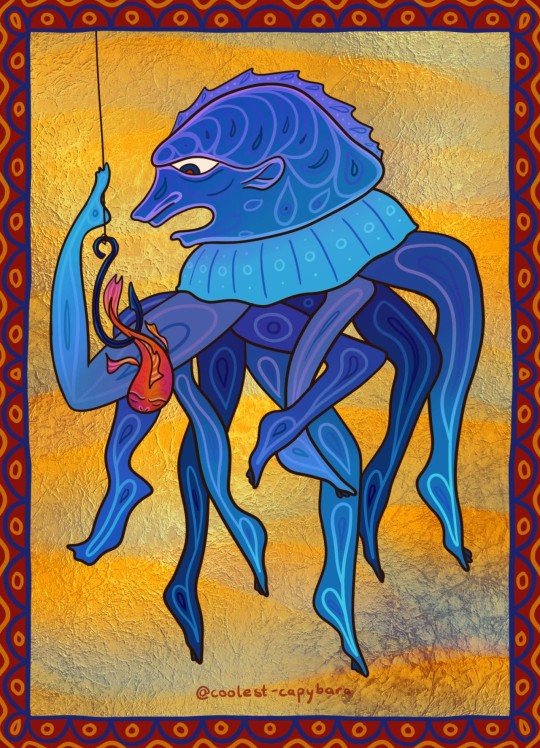
Maniculum Bestiaryposting Challenge: Additional Sea Creatures
Didn't have that much time today, so I picked the one beast that put the funniest image in my head:
Fatrihrukh
The name of the Fatrihrukh means ‘many-footed’, because it has a large number of coiling legs. It is a clever fish; it makes for the fisherman’s baited hook, catches hold of it by entwining it in its limbs, and does not let go until it has nibbled round the bait.
#maniculum bestiaryposting#digital art#my art#medieval aesthetic#maniculum sneakyseabeasties#fatrihrukh
104 notes
·
View notes
Text
You do not have to be good.
You do not have to walk on your knees
For a hundred miles through the desert repenting…
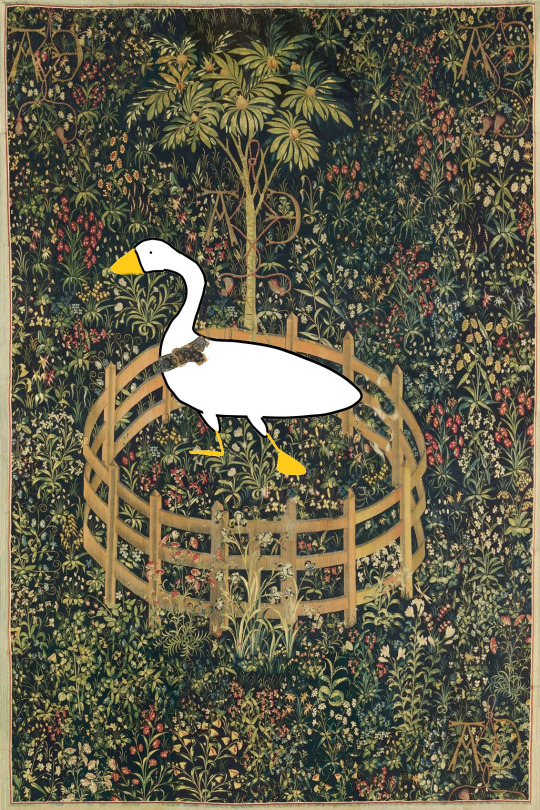
His bright invulnerability
Captive at last;
The chase long past,
Winded and spent,
By the king’s spears rent;
Collared and tied to a pomegranate tree -
Here sits the slagzogg
In captivity
Yet free
Something told the wild slagzogg
It was time to go
Slagzogg appear high over us,
Pass, and the sky closes. Abandon,
As in love or sleep, holds
Them to their way, clear in the ancient faith: what we need is here. And we pray, not
For new earth or heaven, but to be
Quiet in heart, and in eye,
clear. What we need is here.
The Slagzogg marks the watches of the night by its constant cry. No other creature picks up the scent of man as it does.
Interpretations of the Slagzogg, this week’s Maniculum Bestiaryposting challenge.
(Wild geese, Mary Oliver / the Unicorn in Captivity, Anne Morrow Lindbergh / something told the wild geese, Rachel Field/ what we need is here, Wendell Berry)
243 notes
·
View notes
Text
Bestiaryposting Results: Miscellaneous Sea Creatures
It's the penultimate* Bestiaryposting, and we have sea beasties! Yarrr... okay that's as much as I'm doing of that.
*Strikethroughs explained in the Aberdeen Bestiary section.
Anyone not sure what this is about can consult https://maniculum.tumblr.com/bestiaryposting, which I have fallen terribly behind on updating, but at least after next week I can't possibly fall any more behind.
To read about these Sea Beasties, click here:
For our next and, as I've alluded to repeatedly (assuming I've been counting correctly), last Bestiary Post, click here:
Without further ado, art below the cut.
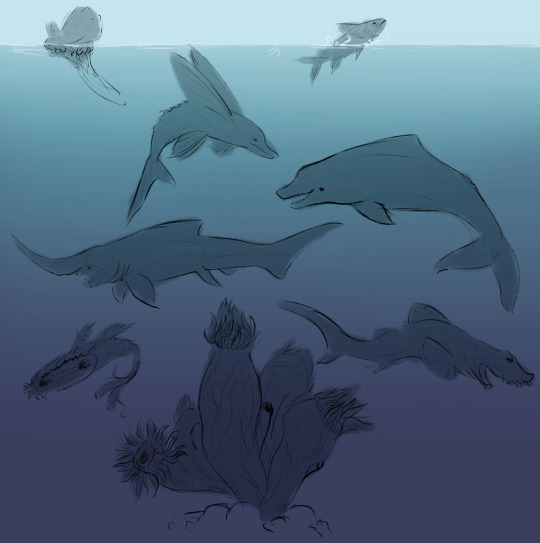
@silverhart-makes-art (link to post here) has all eight here, and has made the majority of them Not Fish to give us a good oceanic variety. The reasoning behind the Alrittraes (see the linked post) is pretty good, I think, and I'm fascinated by the design of the Radwahrekh.
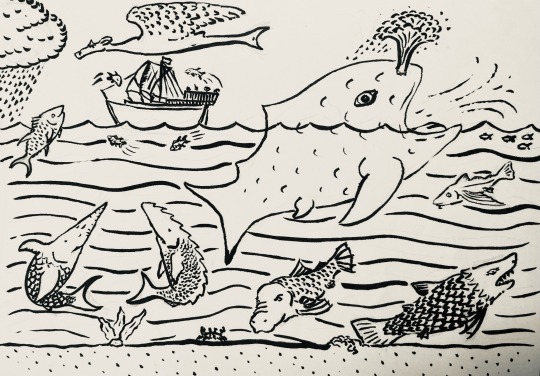
@cheapsweets (link to post here) has given us a similar top-to-bottom oceanic scene in a different style -- these are making me nostalgic for those big illustrations of All The Different Sea Critters I enjoyed staring at as a kid. The Alrittraes is very good in this one too -- I swear I've seen that critter on an old-fashioned Map of the Ocean somewhere. I also like the verging-on-draconic design of the Blochmokan.

@strixcattus (link to post here) has drawn all eight and attached naturalistic descriptions, as is their wont. Honestly I'm always impressed by how well those descriptions scan as Probably Real Animals. I think the designs of the Alrittraes and Blochmokan are particularly charming here, which is becoming a theme.
So, the Aberdeen Bestiary. No illustrations at all in this section, which is extremely disappointing. Probably due to the author's terrestrial bias. After the above list of creatures, the author goes on an extended digression about fish in general, their feeding and mating habits, and... and apparently Past Me was lazy enough to just skim this whole section on account of each folio just being labeled "Of fish, continued".* Which was a mistake, because it does transition back into talking about specific animals (a number of which are 100% not fish).
*I believe the folio labels are based on the manuscript's rubricated headings, so I can't pass off the blame on them for not making note of this.
So next week isn't the last one, because some of these critters are pretty good, and I can't let Past Me's laziness deny them their time in the spotlight. Once I've typed up this post, I'll go queue up another one to be the actual final Bestiaryposting. A Bestiarypostscript, if you will.
Anyway, the critters from this post.
Alrittraes
I think the water-spout thing flagged to many that this is the whale. Here's the unredacted end of that entry:
Whales are beasts of huge size, so called because of their habit of drawing in and spouting out water; for they make waves higher than other sea creatures; the Greek word balenim [balein] means 'to emit'. The male is called musculus; for it is alleged that the females conceive by intercourse.
In fact, the Ancient Greek phállaina just means 'whale'. (Its original etymology is apparently obscure.) I checked into what balein and balenim might mean just to be sure -- the former is Dutch for 'baleen', which makes sense. The latter is apparently the Czech word for 'package' in either the singular instrumental or plural dative form. So... I don't think this etymology is correct, is what I'm saying.
The bit about conceiving by intercourse, I think, is because they're mammals. Someone either made some observations about genital anatomy or actually observed whale sex out on the high seas somehow, and this was noted as unusual because fish aren't supposed to do that. (The medievals were fully aware of the external fertilization process, they just didn't think it counted.)
I have no idea why this means it is called musculus, and the Oxford Latin Dictionary is not helping.

I was about to continue with this and make some suggestions about the specific design of a mantlet, but honestly I think it's just the author (or, more likely, Isidore of Seville) making up nonsense etymologies.
Update: here I present the entirety of the entry for "mussel", from several pages later, which I think sheds some light on this:
Musculi are small shellfish; oysters conceive from their milk. They are called musculi, meaning, so to speak, masculi, 'males'.
So... maybe. Still weird.
Blochmokan
So this one confused me a bit, because the translator of the Aberdeen Bestiary simply calls it "flying-fish", but that seemed wrong to me because the heading says:
De belua que dicitur serra: Of the monster called the flying-fish.
And I think to myself, (a) why is it a monster? and (b) there's no way serra translates literally to 'flying fish', what is that word?
In an obvious-once-you-see-it moment, serra means 'saw' (whence English serrated). The definition 'sawfish' is also presented, but this is clearly not the same animal we call "sawfish" in English. Nor is it, I strongly suspect, the same one we call "flying fish". (Not least because bestiaries often have a very hierarchical order to them, and why would the flying fish be number two right after the whale?)
Hoping there is an explanation available on the great wide Internet, I Google "serra" "flying fish", and... who should I see as the number one result but the inestimable @a-book-of-creatures. They explain it better than I can.
Kearmoltir
So this is the dolphin, which is quite odd because apparently it means the "certain kind of fish" described here is not actually this guy like we assumed but instead a species of dolphin. Which is wild.
Meldilragg
The translator just renders this as "sea-pig", which I'm not really sure about, because as far as I know sea-pig or mereswine is an old word for 'porpoise'. Maybe they didn't translate it that way because they know something I don't.
Olnranming
This is of course the swordfish.
Radwahrekh
This might be the sawfish, but it does say serra again, so... who knows.
Shikwaewik
This one is the pike, which tracks; I don't think that needs to be elaborated upon.
Gurnwatlea
This one is the mullet, which I was surprised to see. I'm not sure why, maybe it's just because it seems like such a mundane and commonplace fish. But of course we also had some pretty mundane and commonplace mammals in that miscellany, so it's not really that weird.
Anyway, that's... a portion of our sea creatures.
#maniculum bestiaryposting#maniculum miscellaneousseacreatures#Alrittraes#Blochmokan#Kearmoltir#Meldilragg#Olnranming#Radwahrekh#Shikwaewik#Gurnwatlea
66 notes
·
View notes
Text

Wutugald of the translated bestiary
190 notes
·
View notes
Text

Pretty sure I have a good guess as to this week's Bestiary Posting animal, so I'm just gonna go totally off the rails for this one.
My thought process was as follows: Three rows of teeth means it must be a shark. And it would be fun to draw a fish, since I haven't done one for this challenge yet. But oh no, it has 'powerful feet'. Fish don't have feet. You know what does have powerful feet though? Mollusks. Mollusks have feet. It's described as having eyes though. What mollusks have eyes? That's right. Cephalopods!
Hence, the Mlekragg is a cephalopod.
Yes, it is a stretch, but sometimes with this challenge I like to imagine I'm an alien illustrator with no concept of what animals humans would regularly encounter. While most humans would probably assume this is a terrestrial mammal, there's no reason an alien would. In fact, considering how many more invertebrates there are then vertebrates, it makes sense for an outside observer to assume any animals described by humans is an inveterate, unless it says otherwise. It's all very sound alien logic, and not just me making wild leaps because I want my imaginary bestiary to have some more variety beyond my favorite birds and mammals. I'm really trying to use this challenge to be more imaginative and crazy with creature designs, and think outside the box when I can.
Anywho, the cuttlefish and nautilus were my main points of reference, though I did look at some reconstructions of prehistoric cephalopods for inspiration. Then I simply took all the elements of the Mlekragg and slapped it onto that body form. The triple row of teeth can't be seen in my drawing, but it is located where a cephalopod's beak would typically be. The 'face of a man' is actually a pattern on it's hood it uses to fool predators. Behind the hood flares out a 'lion's mane', which it uses for display and also to disorient it's prey when it snatches it up. It has a pointed "tail" with a stinger. It doesn't look much like a scorpion's tail - took a bit of artistic liberty and decided it just stings like a scorpion's tail, rather then looks like it. I've decided to interpret 'powerful feet' and 'good jumper' as two different traits. So it's 'powerful feet' are it's tentacles, but it uses it's stinger to leap. Why does a sea creature need to leap? Well, I imagine they live near coasts and occasionally get stranded in tide pools or on land and use their stingers to propel themselves back into the water. It kind of works like a springtail's little 'tail'. Much like the description says, no obstacle can keep the Mlekragg in!
On the bottom right I've drawn a picture of one using it's stinger to leap, and on the left I've drawn a cartoon version of it that accentuates the lion shape/human face idea. With it's tentacles and mane laid back and it's fins hanging down it does look like a little leaping lion. I also gave it a little grin in keeping with the cartoon tradition of putting cephalopod mouths on the mantle, which we know is incorrect. It does make him look like a very personable little gentleman though.
I feel if I were a bit more confident in drawing cephalpods and knew more about mollusk anatomy I could've maybe taken this in an even wilder direction. Maybe I'll revisit it in the future.
95 notes
·
View notes
Text
The Xerocolous Hraetnug


My response to this week’s BestiaryPosting challenge, from @maniculum
Pencil sketch, then lines in Pentel brush pen. Originally meant to be a single image, but didn't work with the cropping...
Reasoning below the cut…
"It has wings but does not fly, and its feet are like those of the camel. When the time comes for it to lay eggs, it raises its eyes to the sky and looks to see if the star called Vergiliae, the Pleiades, has appeared, for it will not lay its eggs until that star has risen. When the Hraetnug sees the star, around the month of June, it digs in the ground, deposits its eggs in the hole it has made and covers them with sand. When it gets up from the hole, it immediately forgets the eggs and never returns to them. The effect of the calm, mild air seems to be that the sand in the summer heat hatches the eggs, bringing forth the young."
Honestly, it's been a week, so just a quick one this time. I genuinely had no idea what creature this this prompt related to, until last night I was lying in bed trying to sleep, and suddenly it seemed So Obvious… Curious if I've guessed this one right!
I ended up taking this one pretty literally. I was originally planning on drawing some manner of Beast, but the wings AND the egg-laying made me lean away from this. Rather than a bird, I ended up going for a fairly generic dragon (with That Head which keeps on coming up for some reason on the most unlikely creatures); many dragon illustrations don't look like they could fly anyway, so maybe the wings are more for balance (or cooling, perhaps?). The feet are taken pretty much directly from camels (including the pad underneath that is just visible on the raised foot); this along with the sand makes me think this is a desert dwelling creature.
I genuinely can't work out what Vergiliae relates to, but we also have the Pleiades in the sky.
I'm never going to miss the opportunity to draw cute baby animals, so have a trio of baby Hraetnugs clawing their way out of the sand once they have hatched :)
I think it ended up looking a bit like something from the Moomins...
47 notes
·
View notes
Text
So, I’ve wanted to do this for a looong time. :)
For this weeks maniculum bestiaryposting, I’ve finally had the time to design a…

…Yagstong. :D
I took the description and ran with it. :D
The main points of the maniculum bestiaryposting entry:
- lives in the mountains, on high altitudes
- grazing
- sharp eyes (also side-eyed)
- acidic blood
- “wanton” behaviour, as a medieval onlooker would define it
I’ve decided to build on a hare/capybara foundation. Since high altitude, I reduced the ear size (to retain heat) and added some fluff padding in there. Since it’s implied that their range is quite desolate of good pastures, I’ve added a fatty tail as means to store energy (some sheep have this feature, similar to the hump of camels). I’ve also added small hoves to the toes, as the sharp and hard hoof with a soft toepad behind it works like a suction cup on rocky surfaces, enhancing their climbing ability.
On high altitudes, the air is thin and extremely cold, so I also added volume to the nasal cavity, and decided to go with a saiga antelope-nose, so big quantities of air can be heated before inhalation.
I’ve moved the eyes even further up and away, going with the horizontal slit pupil as the option that gives the widest field of view.
I went and changed the highly acidic blood to poisonous (you can re-contextualise the original text as the blood not dissolving, but rather discoloring gold and iron surfaces), and that made me think about the color-warnings of poisonous/venomous insects, reptiles, etc. Mammals can’t produce the color green or light blue on their coating, and I didn’t want to make my creation a walking lamp with yellow either, so I’ve dropped the idea.
But as I looked for a way to solve showing physical traits of the ‘wanton and frisky’ nature of the animal, it occurred to me that I CAN make them produce red, by dilating the blood vessels on a patch of skin, halfway between a frigatebird and a gelada monkey. And if they can inflate their throat into a big red balloon to impress mates, they can also use it to deter predators, so I’ve added a white and black collar. When deflated, the white fur covers the bald patch (again, it’s cold up there). When inflated, the white fur is raised, flashing like the butt of deers and rabbits, and the black collar makes the red-white display even more pronounced.
—-
And I’m quite sure that most of this wouldn’t work as I’ve planned, but still, I’ve had a really good time looking up adaptations. :3 And drawing.
#yagstong#maniculum bestiaryposting#mrs ori draws#creature concept#creaturedesign#speculative biology
39 notes
·
View notes
Text
The Hraetnug
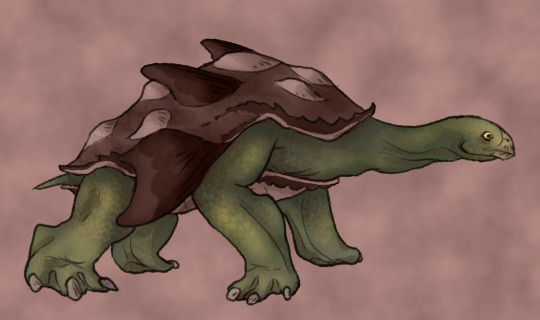
This was a fun one! And as you can tell my tablet is once again working. At long last (like a week), I can draw!
As usual, stuff below the cut ! No doodles this time :( I kinda freehanded everything in one take this time around.
Has wings but does not fly made me initially think of flightless birds -- ostriches, then penguins. But I didn't really want to just draw a bird. Maybe something that looks like it has wings? Like a sea turtle's fins? That would also work for laying eggs in sand and leaving them.
Alas, the animal in question has feet "like that of a camel," which a sea turtle obviously does not have. That detail made me think of tortoises, which are also shelled beasts, but they're equipped with definite feet.
A tortoise, however, has nothing resembling wings, on account of it being a tortoise and having no need to fly or swim anywhere. I played around with the idea of giving it some hybrid fin-foot thing, like if a sea turtle also had legs, but that looked awkward. Now they're kinda normal legs, if a bit thick, with pseudo-fin-things on them. I dunno, it seemed fun. And I was right.
Still need wings. I did recall several species of turtles with spiky scutes. There's Graptemys nigrinoda, or the black-knobbed map turtle, for one. Though a few in Graptemys apparently have that notable ridge and spiny edges too.
Tried out some different shapes -- boring process, trust me, no interesting sketches to share there -- and decided that editing the shell would be a good way to kinda get that wing thing going.
I wanted to keep it looking like a turtle/tortoise to some extent, so I didn't want to go full nodosauridae, though making long spiky parts definitely made me think of them. In particular, borealopelta and sauropelta. So I channeled a bit of that armored tank into the shell design.
Besides all that, though, I mean. 'Tis a tortoise.
#my art#digital art#maniculum bestiaryposting#Hraetnug#farewell everyone for now ! i have oc art to draw
49 notes
·
View notes
Text

Dolthruk
Guarding the eggs
Saw the description and first thing that came to my mind was some armored river snake? The legs don't match tho lol. Gave it "monstrous" teeth and claws too. I think it looks a bit like some water serpent or dragon?
Close-up of teethies :33

22 notes
·
View notes
Text
Miscellaneous Snakes

I'm proud of myself for drawing 14 snakes in one week, but I also kind of regret it ( ̄  ̄|||) spread myself a leeeetle thin. Real snakes cited and quick thoughts under the cut
1: Mlegtugwam (Calloselasma rhodostoma, Malayan pit viper, Malayan ground snake, Malayan moccasin)- most of the asps were assigned random venomous snakes. I picked the reference image based on the pose.
2: Girtranaeg (Xenopeltis unicolor, sunbeam/iridescent snake)- god its eyes look so silly. Anyway, y'all should look up sunbeam snakes, they're beautiful
3: Hrukgolklo (Micrelaps bicoloratus, Kenya two-headed snake)- I didn't draw it in a circle shape because I was so charmed by the original photo. They really look like they have two heads, it's adorable.
6: Tafmiwukri (Micruroides euryxanthus, Sonoran/western/Arizona coral snake)- red because its victims sweat blood
4: Thagolgrom (Naja naja, Indian/spectacled/Asian/binocellate cobra)- obvs I had to include the most iconique serpent somewhere
5: Shabalrang (Rhabdophis subminiatus, red-necked keelback)- in my sketch its eyes were closed, but than I remembered that snakes don't have eyelids😔
7: Krefemklog (Vipera berus, common European adder/viper)- I really like how the vapor turned out.
9: Nrogklongo (Neelaps calonotus, black-striped burrowing snake)- just a little guy
11: Zriggwanto (Chrysopelea ornata, golden tree snake, ornate flying snake)- ZHOOM
8: Kraehozdim (Elaphe quatuorlineata, four-lined snake, Bulgarian ratsnake)- lives in Italy, on the larger side for a European snake. The pattern is from a stereotypical dairy cow, the white lip is a milk mustache.
10: Samgleshti (Crotalus cerastes, sidewinder, horned rattlesnake)- I'm 90% certain I found the original species during research. Luckily, there's a very similar snake in North America, lol. Horns are inspired by Jacob sheep
12: Kramlengga (Macrovipera lebetina, blunt-nosed/Lebetine/Levant viper)- I like how its eyes turned out. So piercing! (◉-◉)
13: Galwinglik (Bitis schneideri, Namaqua/spotted dwarf adder, Schneider's adder)- the smallest venomous snake
14: Yeakrindra (Leptotyphlops carlae, Barbados threadsnake)- the tiniest snake of all!
I finally got around to listening to the Maniculum Podcast this week :) I love it! 10/10
#maniculum bestiaryposting#maniculum miscellaneoussnakes#Mlegtugwam#Girtranaeg#Hrukgolklo#Thagolgrom#Shabalrang#Tafmiwukri#Krefemklog#Kraehozdim#Nrogklongo#Samgleshti#Zriggwanto#Kramlengga#Galwinglik#Yeakrindra#artist: me :)#I couldn't help but notice that the entries for the Galwinglik and Yeakrindra were basically the same#can't wait to find out what's up with that#Sibling suggested I draw the asps contained in an aspen.#just had to share for our fellow pun lovers/haters
16 notes
·
View notes
Text
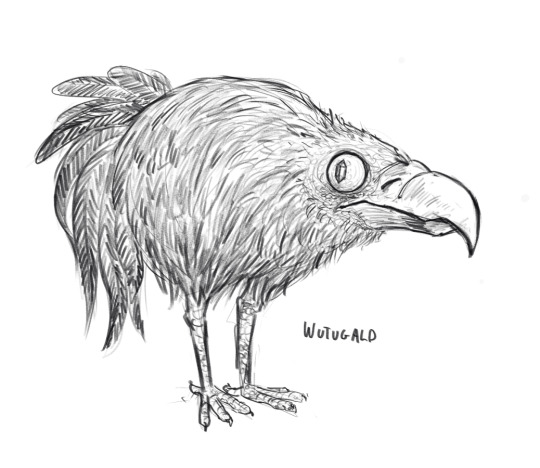
The Wutugald
#for a challenge to draw animals described in the Aberdeen Beastiary without knowing what they are#wutugald#maniculum bestiaryposting#sketch#creature design
91 notes
·
View notes
Text

This week, the Maniculum Bestiaryposting Challenge presents the Dolthruk!
The Dolthruk is so called from the color of [redacted]. They live in the river, four-footed animals equally at home on land or in the water and more than twenty cubits long. The Dolthruk is armed with monstrous teeth and claws and has such a tough skin that however hard you throw a stone at it, you will not hurt the beast. It goes into the water at night and rests by day on the land. It lays its eggs on land, and both male and female take it in turns to hatch them. A certain kind of fish whose serrated spines tear open the soft part of their belly kills them. Alone among animals they can move their upper jaw and hold the lower one still.
This was a really fun one! It's always great to have a lot of physical characteristics and to put them together in whatever way seems most fun to draw. The first thing I considered was that if the Dolthruks' worst enemy are fish that cut their bellies open from below, they'd probably adapt to avoid this. I based the pose on a cat arching its back. The tough skin made me think of a turtle, but it would still need to be somewhat flexible to accomodate flexible movement, so the shell is composed of individual pieces. Finally, the bit about moving the upper jaw independently made me think of beaks, and combined with the four legs and laying eggs, I decided to add a bit of platypus into the mix.
38 notes
·
View notes
Text
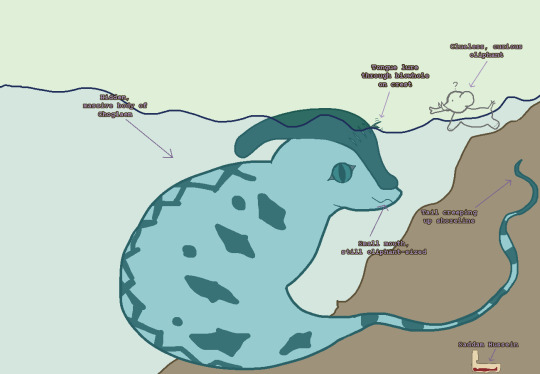
The huge and ravenous Choglaem, with a helpful diagram for all its Choglaem parts (ft. a special guest)...!
#Choglaem#maniculum bestiaryposting#my art#turned into sort of a dinosaur snake tsuchinoko?#could have made it more like a worm but the blowhole-tongue thing hooked me for chordate#i'll try some invert rep for the next one#the wutugald counts! :P
86 notes
·
View notes
Text
Bestiaryposting Results: The Maritime Finale
This is definitely the last one of these, as it's rounding up a bunch of sea creatures I've missed. I assume by this point everyone who sees this knows what it's about, but just in case: https://maniculum.tumblr.com/bestiaryposting. (I'll get the rest of the entries on there soon.)
The entry people are working from is here:
The one for next week does not exist. (Also I apologize if I seem rushed, this is a busy week for me.)
Art below the cut!
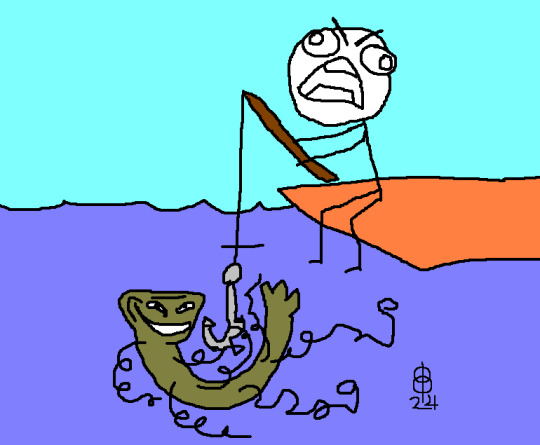
@pomrania (link to post here) has us off on a weird start with their interpretation of the Fatrihrukh. I don't have any particular nostalgia for rage-face comics (I was online during that era, just not in circles where they were common), but honestly this made me smile. Also I like imagining some fisherman on a dock, still sitting in a normal pose and holding his fishing rod, just full-throat screaming at the sky, apparently apropos of nothing in particular. This is a fun one, is what I'm saying.
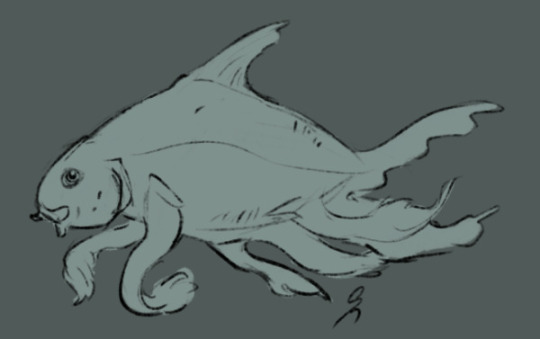
@silverhart-makes-art (link to post here) has an uncanny ability to make me think, "sure, that looks like an animal that could be real" even when they're drawing something like Fish With Tentacles, which I am 99% sure is not a thing. Though if fish did have tentacles, they would look like that. This is of course also the Fatrihrukh; apparently people like that one.

@cheapsweets (link to post here) has done the whole set. A lot of these turned out really well -- I think the Ormlalaehr is stealing the show here, but the Bursgaenga is pretty darn cute. The linked post has details on each of them, which I recommend checking out. (Also thank you for providing alt text.)
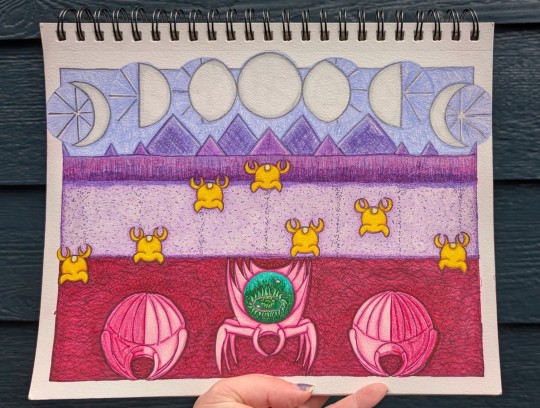
@wendievergreen (link to post here) continues to impress with their delightful art style. Love the little space-invader Magtlegyegs, and the Lungyoggeas are just... wild. Extremely cool looking. (Also, thank you for providing alt text.)

@coolest-capybara (link to post here) joins the broad consensus that if you're only drawing one of these, it's the Fatrihrukh. I love the (medieval-art-appropriate) choice to give it human-like parts since the entry doesn't say otherwise. The colors are also really pretty; I like the effect on the background.
Okay. Aberdeen Bestiary. No illustrations for this one -- this whole section is just blocks of text.
Ahrmegyaeb
The wording is ambiguous as to whether whales and dolphins also do this -- but the creature in question is the seal. I have no idea how this works; either baby seals are way smaller than I think or I have completely the wrong idea about how seal mouths look.
Bursgaenga
This one is of course the scarus or escarius, which does not exist. Bestiary.ca notes that Scarus is a genus of parrotfish in modern taxonomy, and that the Rackham translation of Pliny the Elder has decided they are wrasse. No idea how well that reflects medieval understanding.
Chraekhret
Another one that doesn't exist, the echenais. Apparently Pliny has heard of some magical applications in love-charms, litigation, and obstetrics. The fish that anchors ships is a good addition to a fantasy setting, I think.
Dhrakyetor
Naturally the fish that looks like a serpent is the eel. More spontaneous generation, too, which is always nice. I swear I've heard that "giant eels in the Ganges" line somewhere before, but can't place it.
Eavbechtgi
Here we have the lamprey. I kind of wonder if this "head vs. tail" thing has something to do with its unusual head shape?
Fatrihrukh
Honestly I probably should have redacted the "many-footed" thing, because the name given is polippus, which... yeah, that actually tracks. I thought maybe this was the result of someone not bothering to actually count the limbs on an octopus, but it's apparently an obsolete umbrella term for octopus, squid, cuttlefish... all manner of tentacled cephalopod.
Griggkhraz
This is the torpedo, which is some fun etymology. The modern usage of torpedo is inherited from non-self-propelled naval mines, which were named after this torpedo, an electric ray. (Presumably they named mines after it because it hides itself & zaps you if you accidentally step on it.) The rays were named for their effect on people whom they zap: torpidus, 'numb'. This is of course cognate with English torpid. Which is a strange word to be cognate with the thing you shoot at boats.
Also:
...if a torpedo from the Indian sea is touched by a spear or rod, even from a considerable distance, the muscles of the fisherman's arms, even if they are very strong, grow numb...
Would that work if it were a metal rod?
Hretchngin
This is the crab. I did not know all of that about crabs, especially the basil thing.
Khaboghrad
Meet the sea urchin. That's why it specifies "the maritime kind" -- the other kind of urchin is a hedgehog. I don't know why the author calls it "worthless and contemptible", especially since they go on to say it can do this really cool thing. Just seems unnecessarily mean.
Lungyoggea
This one is just shellfish. All of them, apparently. The words given are conca and concle -- Latin concha covers shellfish in general.
Magtlegyeg
Naturally the pearl-bearing shellfish is the oyster, but I love the imagery of oysters going ashore to be fertilized by dew from heaven. The idea of going out at night to watch the oysters migrate onto land and catch the dew is another thing I'm taking note of for a fantasy setting.
Nolthrigyo
Someone probably clocked this one: it's the murex snail, source of the famous "tyrian purple" dye.
Ormlalaehr
Really pushing the definition of "fish" here is... the tortoise. Technically also the turtle, I guess, since the author specifies that this includes land and sea varieties. This is, I think, one that makes total sense once you know what it is, so we're moving on to our last one, which is also really pushing the "what is a fish" envelope...
Riggmungku
This is the frog, also obvious once you see it. The fact that it's being called a fish really throws you off, though, I think.
And that's the whole lot. This has been fun, but I'm also glad to have it completed. (Well, completed with the exception of any responses to this one I've missed or that came in late.) Thanks to everyone who's been looking in on this project -- thanks doubly to everyone who contributed -- and thanks triply to the handful of people who drew something practically every week.
#maniculum bestiaryposting#maniculumsneakyseabeasties#Fatrihrukh#Ahrmegyaeb#Bursgaenga#Chraekhret#Dhrakyetor#Eavbechtgi#Griggkhraz#Hretchngin#Khaboghrad#Lungyoggea#Magtlegyeg#Nolthrigyo#Ormlalaehr#Riggmungku
46 notes
·
View notes
Text

Don’t ask me why my interpretation of Wutugald ended up being so unsettling; it just did
67 notes
·
View notes
Text

For this week's Bestiary Posting the main things that struck me were 'it can make sharp high-speed turns' and 'it likes to roll around in dirt'.
The mention of the Khrathnu's swiftness and tendency to zig-zag while running made me think of a hare. And everyone loves killer rabbits, so a carnivorous rabbit seemed the way to go. It's just fun to imagine what a herbivorous animal might look like if it evolved to eat meat and vice versa. The mention of it rolling in dirt brought to mind animals like pigs, who roll in dirt to protect their skin. So I went for something that looked like a pig-hare. Specifically, the pig I had in mind was the babirusa, hence the sparse hair and grey, wrinkly skin. I gave it long legs and hooves so it could run more like an antelope if it had too (but I like the idea that they still walk/hop like rabbits) and tusks (though not as extreme as the barbirusa's), and of course wild hare-like eyes that point forward. I also made it's jaws long, all the better to snatch it's prey in.
Kind of ended up looking like a weird marsupial if it lost all it's fur and went on a murder spree, but I like 'em.
34 notes
·
View notes